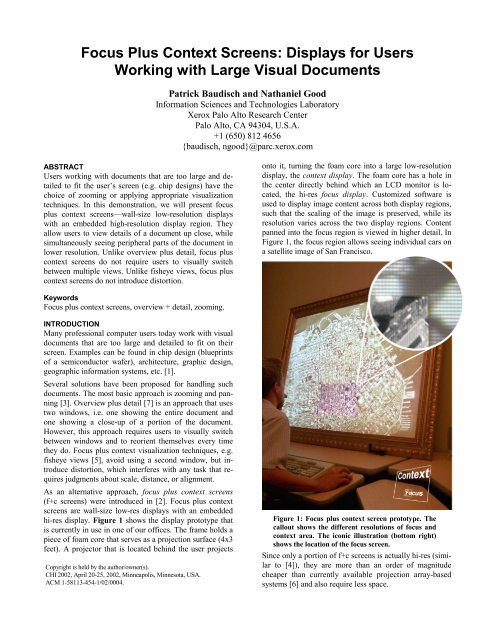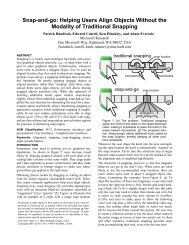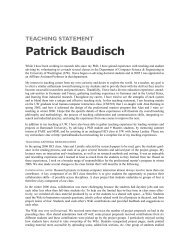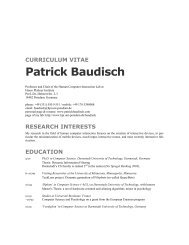Focus plus context screens: Displays for users ... - Patrick Baudisch
Focus plus context screens: Displays for users ... - Patrick Baudisch
Focus plus context screens: Displays for users ... - Patrick Baudisch
You also want an ePaper? Increase the reach of your titles
YUMPU automatically turns print PDFs into web optimized ePapers that Google loves.
)RFXV 3OXV &RQWH[W 6FUHHQV 'LVSOD\V IRU 8VHUV<br />
:RUNLQJ ZLWK /DUJH 9LVXDO 'RFXPHQWV<br />
$%675$&7<br />
Users working with documents that are too large and detailed<br />
to fit the user’s screen (e.g. chip designs) have the<br />
choice of zooming or applying appropriate visualization<br />
techniques. In this demonstration, we will present focus<br />
<strong>plus</strong> <strong>context</strong> <strong>screens</strong>—wall-size low-resolution displays<br />
with an embedded high-resolution display region. They<br />
allow <strong>users</strong> to view details of a document up close, while<br />
simultaneously seeing peripheral parts of the document in<br />
lower resolution. Unlike overview <strong>plus</strong> detail, focus <strong>plus</strong><br />
<strong>context</strong> <strong>screens</strong> do not require <strong>users</strong> to visually switch<br />
between multiple views. Unlike fisheye views, focus <strong>plus</strong><br />
<strong>context</strong> <strong>screens</strong> do not introduce distortion.<br />
.H\ZRUGV<br />
<strong>Focus</strong> <strong>plus</strong> <strong>context</strong> <strong>screens</strong>, overview + detail, zooming.<br />
,1752'8&7,21<br />
Many professional computer <strong>users</strong> today work with visual<br />
documents that are too large and detailed to fit on their<br />
screen. Examples can be found in chip design (blueprints<br />
of a semiconductor wafer), architecture, graphic design,<br />
geographic in<strong>for</strong>mation systems, etc. [1].<br />
Several solutions have been proposed <strong>for</strong> handling such<br />
documents. The most basic approach is zooming and panning<br />
[3]. Overview <strong>plus</strong> detail [7] is an approach that uses<br />
two windows, i.e. one showing the entire document and<br />
one showing a close-up of a portion of the document.<br />
However, this approach requires <strong>users</strong> to visually switch<br />
between windows and to reorient themselves every time<br />
they do. <strong>Focus</strong> <strong>plus</strong> <strong>context</strong> visualization techniques, e.g.<br />
fisheye views [5], avoid using a second window, but introduce<br />
distortion, which interferes with any task that requires<br />
judgments about scale, distance, or alignment.<br />
As an alternative approach, focus <strong>plus</strong> <strong>context</strong> <strong>screens</strong><br />
(f+c <strong>screens</strong>) were introduced in [2]. <strong>Focus</strong> <strong>plus</strong> <strong>context</strong><br />
<strong>screens</strong> are wall-size low-res displays with an embedded<br />
hi-res display. Figure 1 shows the display prototype that<br />
is currently in use in one of our offices. The frame holds a<br />
piece of foam core that serves as a projection surface (4x3<br />
feet). A projector that is located behind the user projects<br />
Copyright is held by the author/owner(s).<br />
CHI 2002, April 20-25, 2002, Minneapolis, Minnesota, USA.<br />
ACM 1-58113-454-1/02/0004.<br />
<strong>Patrick</strong> <strong>Baudisch</strong> and Nathaniel Good<br />
In<strong>for</strong>mation Sciences and Technologies Laboratory<br />
Xerox Palo Alto Research Center<br />
Palo Alto, CA 94304, U.S.A.<br />
+1 (650) 812 4656<br />
{baudisch, ngood}@parc.xerox.com<br />
onto it, turning the foam core into a large low-resolution<br />
display, the <strong>context</strong> display. The foam core has a hole in<br />
the center directly behind which an LCD monitor is located,<br />
the hi-res focus display. Customized software is<br />
used to display image content across both display regions,<br />
such that the scaling of the image is preserved, while its<br />
resolution varies across the two display regions. Content<br />
panned into the focus region is viewed in higher detail. In<br />
Figure 1, the focus region allows seeing individual cars on<br />
a satellite image of San Francisco.<br />
Figure 1: <strong>Focus</strong> <strong>plus</strong> <strong>context</strong> screen prototype. The<br />
callout shows the different resolutions of focus and<br />
<strong>context</strong> area. The iconic illustration (bottom right)<br />
shows the location of the focus screen.<br />
Since only a portion of f+c <strong>screens</strong> is actually hi-res (similar<br />
to [4]), they are more than an order of magnitude<br />
cheaper than currently available projection array-based<br />
systems [6] and also require less space.
$33/,&$7,216 $1' 7$6.6 21 ) & 6&5((16<br />
In the following, we will briefly present some of the applications<br />
we have adapted to run on f+c <strong>screens</strong>.<br />
Figure 2: <strong>Focus</strong> <strong>plus</strong> <strong>context</strong> <strong>screens</strong> allow editing<br />
details of a drawing “in <strong>context</strong>” (Adobe Illustrator).<br />
To obtain a print product that looks perfect from a distance<br />
as well as up-close, editors have to work with their<br />
artwork at many different zoom levels. On an f+c screen,<br />
editors of print products can work on details while constantly<br />
being aware of the detail’s <strong>context</strong>, making it easier<br />
to judge how a detail modifications will affect the<br />
overall impression (Figure 2, Adobe Illustrator, enabled<br />
using a plug-in). Other visual applications (e.g. the image<br />
editor GIMP, Star Office, Netscape. etc.) can be run on<br />
our adaptation of the Linux operating system (using VNC<br />
http://www.uk.research.att.com/vnc) [2].<br />
Figure 3: Working with large images and drawings<br />
on a focus <strong>plus</strong> <strong>context</strong> screen under Linux.<br />
F+c <strong>screens</strong> are equally useful <strong>for</strong> a large variety of tasks<br />
dealing with dynamic content. In a videoconference scenario,<br />
f+c <strong>screens</strong> allow simultaneous display of the remote<br />
partner and the detail in<strong>for</strong>mation that this person<br />
presents, e.g. readable text (Figure 4a). F+c <strong>screens</strong> allow<br />
<strong>users</strong> to simultaneously perceive the periphery while focusing<br />
on a detail. Such scenarios can be found in realworld<br />
situations, such as the control of remote operated<br />
vehicles via a video connection [1], as well as in simulation<br />
games. The first person shooter, Unreal Tournament<br />
(http://www.unrealtournament.com), requires players to<br />
be constantly focused on the crosshair at the screen center<br />
(Figure 4b). Since human vision in the peripheral regions<br />
is limited to low-res, an f+c screen produces the same user<br />
experience as if the entire display was hi-res.<br />
Figure 4 (a) A videoconference on an f+c screen. The<br />
higher resolution in the focus region allows communicating<br />
relevant details, such as text. (b) F+c<br />
<strong>screens</strong> allow players of 3D games to perceive their<br />
surrounding through peripheral vision.<br />
&21&/86,216<br />
In this paper, we presented focus <strong>plus</strong> <strong>context</strong> <strong>screens</strong> as a<br />
means <strong>for</strong> supporting <strong>users</strong> working with large visual content.<br />
By using a new type of hybrid display setup, f+c<br />
<strong>screens</strong> can outper<strong>for</strong>m existing visualization techniques,<br />
such as overview <strong>plus</strong> detail and zooming/panning [1]. In<br />
future work, we plan to carry out a long-term study evaluating<br />
f+c <strong>screens</strong> as a habitat.<br />
5()(5(1&(6<br />
1. <strong>Baudisch</strong>, P., Good, N., Bellotti, V, Schraedley, P.: Keeping<br />
Things in Context: A Comparative Evaluation of <strong>Focus</strong> Plus<br />
Context Screens, Overviews, and Zooming, Proc. of CHI’02.<br />
2. <strong>Baudisch</strong>, P., Good, N., Stewart, P. <strong>Focus</strong> <strong>plus</strong> <strong>context</strong><br />
<strong>screens</strong>: combining display technology with visualization<br />
techniques, Proc. of UIST ’01, p. 31-40.<br />
3. Bederson, B. B., and Hollan, J.D. Pad++: A zooming<br />
graphical interface <strong>for</strong> exploring alternate interface physics,<br />
in Proc. of UIST’ 94, p. 17–26. New York, ACM, 1994.<br />
4. Feiner, S. and Shamash, A. Hybrid user interfaces: breeding<br />
virtually bigger interfaces <strong>for</strong> physically smaller computers,<br />
in Proc. of UIST ’91, p. 9–17. New York, ACM, 1991.<br />
5. Furnas, G. Generalized fisheye views. In Proc. of CHI ‘86,<br />
p. 16–23. New York, ACM, 1986.<br />
6. Hereld, M., Judson, I., Stevens, R., Introduction to Building<br />
Projection-based Tiled Display Systems IEEE Computer<br />
Graphics & Applications 20(4), 2000.<br />
7. Plaisant, C., Carr, D., Shneiderman, B., Image browsers:<br />
Taxonomy and design guidelines, IEEE Software, 12,2<br />
(March 1995), 21-32.<br />
b<br />
a






